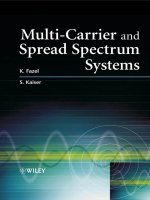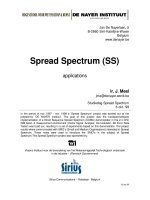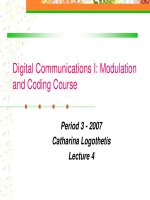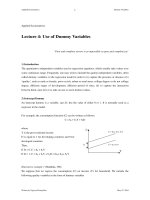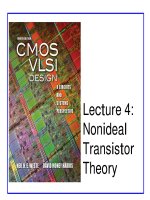Lecture 4 - Spread Spectrum Technologies
Bạn đang xem bản rút gọn của tài liệu. Xem và tải ngay bản đầy đủ của tài liệu tại đây (1.15 MB, 58 trang )
February 2005 Copyright 2005 All Rights Reserved 1
Spread Spectrum
Technologies
(1 September, 2006)
February 2005 Copyright 2005 All Rights Reserved 2
●
Define spread spectrum technologies and how
they are used
●
Describe modulation and the different data rates
●
Explain and compare FHSS, DSSS and OFDM
●
List the factors that impact signal throughput and
range
Objectives
Upon completion of this chapter you will be able to:
February 2005 Copyright 2005 All Rights Reserved 3
Spread Spectrum
●
Spread spectrum is a communication technique that spreads
a narrowband communication signal over a wide range of
frequencies for transmission then de-spreads it into the original
data bandwidth at the receive.
●
Spread spectrum is characterized by:
✔
wide bandwidth and
✔
low power
●
Jamming and interference have less effect on Spread
spectrum because it is:
✔
Resembles noise
✔
Hard to detect
✔
Hard to intercept
February 2005 Copyright 2005 All Rights Reserved 4
Narrowband vs Spread Spectrum
Frequency
Power
Spread Spectrum
(Low Peak Power)
Narrowband
(High Peak Power)
February 2005 Copyright 2005 All Rights Reserved 5
Narrow Band vs Spread Spectrum
●
Narrow Band
✔
Uses only enough frequency spectrum to carry the signal
✔
High peak power
✔
Easily jammed
●
Spread Spectrum
✔
The bandwidth is much wider than required to send to the
signal.
✔
Low peak power
✔
Hard to detect
✔
Hard to intercept
✔
Difficult to jam
February 2005 Copyright 2005 All Rights Reserved 6
Spread Spectrum Use
●
In the 1980s FCC implemented a set of rules making Spread
Spectrum available to the public.
✔
Cordless Telephones
✔
Global Positioning Systems (GPS)
✔
Cell Phones
✔
Personal Communication Systems
✔
Wireless video cameras
●
Local Area Networks
✔
Wireless Local Area Networks (WLAN)
✔
Wireless Personal Area Network (WPAN)
✔
Wireless Metropolitan Area Network (WMAN)
✔
Wireless Wide Area Network (WWAN)
February 2005 Copyright 2005 All Rights Reserved 7
FCC Specifications
●
The Code of Federal Regulations (CFR) Part 15 originally only
described two spread spectrum techniques to be used in the
licensed free Industrial, Scientific, Medical (ISM) band, 2.4
GHz, thus 802.11 and 802.11b.
✔
Frequency Hopping Spread Spectrum (FHSS) and
✔
Direct Sequence spread Spectrum (DSSS)
●
Orthogonal Frequency Division Multiplexing (OFDM) was
not covered by the CFR and would have required licensing.
✔
802.11a, employing OFDM, was created to work in the 5GHz
Unlicensed National Information Infrastructure (UNII)
●
In May, 2001 CFR, Part 15 was modified to allow alternative
"digital modulation techniques".
✔
This resulted in 802.11g which employs OFDM in the 2.4
GHz range
February 2005 Copyright 2005 All Rights Reserved 8
Wireless LAN Networks
●
Wireless LANs RF spread spectrum management techniques
✔
Frequency Hopping Spread Spectrum (FHSS).
☛
Operates in the 2.4 Ghz range
☛
Rapid frequency switching – 2.5 hops per second w/ a dwell time of 400ms.
☛
A predetermined pseudorandom pattern
☛
Fast Setting frequency synthesizers.
✔
Direct Sequence Spread Spectrum (DSSS)
☛
Operates in the 2.4 GHz range
☛
Digital Data signal is inserted into a higher data rate chipping code.
❋
A Chipping code is a bit sequence consisting of a redundant bit pattern.
❋
Barker, Gold, M-sequence and Kasami codes are employed
✔
Orthogonal Frequency Division Multiplexing (OFDM)
☛
Operates in both the 5 Ghz and 2.4 GHz range with a data rate of between 6
and 54 Mbps.
☛
802.11a divides each channel into 52 low-speed sub-channels
✽
48 sub-channels are for data while the other 4 are pilot carriers.
☛
The modulation scheme can be either BPSK, QPSK or QAM depending
upon the speed of transmission.
February 2005 Copyright 2005 All Rights Reserved 9
FCC Radio Spectrum
VLF 10 kHz - 30 kHz Cable Locating Equipment
LF 30 kHz - 300 kHz Maritime Mobile Service.
MF 300 kHz - 3 MHz Aircraft navigation, ham radio and
Avalanche transceivers.
HF 3 MHz - 30 MHz CB radios, CAP, Radio telephone,
and Radio Astronomy.
VHF 30 MHz - 328.6 MHZ Cordless phones, Televisions, RC
Cars, Aircraft, police and business radios.
UHF 328.6 MHz - 2.9 GHz police radios, fire radios, business
radios, cellular phones, GPS, paging,
wireless networks and cordless phones.
SHF 2.9 GHz - 30 GHz Doppler weather radar, satellite
communications.
EHF 30 GHz and above Radio astronomy, military systems,
vehicle radar systems, ham radio.
Band Name Range Usage
February 2005 Copyright 2005 All Rights Reserved 10
ISM Frequency Bands
UHF ISM 902 - 928 Mhz
S-Band 2 - 4 Ghz
S-Band ISM (802.11b) 2.4 - 2.5 Ghz
C-Band 4 - 8 Ghz
C-Band Satellite downlink 3.7 - 4.2Ghz
C-Band Radar (weather) 5.25 - 5.925 Ghz
C-Band ISM (802.11a) 5.725 - 5.875 Ghz
C-Band satellite uplink 5.925-6.425 Ghz
X-Band 8-12 Ghz
X-Band Radar (police/weather) 9.5-10.55 Ghz
Ku-band 12-18 Ghz
Ku-band Radar (Police) 13.5-15 Ghz
15.7-17.7 Ghz
ISM - Industrial, Scientific and Medical
February 2005 Copyright 2005 All Rights Reserved 11
FHSS
February 2005 Copyright 2005 All Rights Reserved 12
Frequency Hopping Spread Spectrum
●
Carrier changes frequency (HOPS)
according to a pseudorandom Sequence.
✔
Pseudorandom sequence is a list of frequencies. The
carrier hops through this lists of frequencies.
✔
The carrier then repeats this pattern.
✔
During Dwell Time the carrier remains at a certain
frequency.
✔
During Hop Time the carrier hops to the next frequency.
✔
The data is spread over 83 MHz in the 2.4 GHz ISM band.
✔
This signal is resistant but not immune to narrow band
interference.
February 2005 Copyright 2005 All Rights Reserved 13
Channel 1 Channel 2
Channel 78
Elapsed Time in Milliseconds (ms)
200 400 600
800
1000 1200 1400 1600
2.401
2.479
Transmission Frequency (GHz)
Divided into 79
1 MHz Channels
Frequency Hopping Spread Spectrum
An Example of a Co-located Frequency Hopping System
February 2005 Copyright 2005 All Rights Reserved 14
FHSS Contd
●
The original 802.11 FHSS standard supports 1 and
2 Mbps data rate.
✔
FHSS uses the 2.402 – 2.480 GHz frequency range in the ISM band.
✔
It splits the band into 79 non-overlapping channels with each channel
1 MHz wide.
✔
FHSS hops between channels at a minimum rate of 2.5 times per
second. Each hop must cover at least 6 MHz
✔
The hopping channels for the US and Europe are shown below.
February 2005 Copyright 2005 All Rights Reserved 15
FHSS Contd
●
Dwell Time
✔
The Dwell time per frequency is around 100 ms
(The FCC specifies a dwell time of 400 ms per carrier
frequency in any 30 second time period).
✔
Longer dwell time = greater throughput.
✔
Shorter dwell time = less throughput
●
Hop Time
✔
Is measured in microseconds (us) and is
generally around 200-300 us.
February 2005 Copyright 2005 All Rights Reserved 16
FHSS Contd
●
Gaussian Frequency Shift Keying
✔
The FHSS Physical sublayer modulates the data stream using
Gaussian Frequency Shift Keying (GFSK).
✔
Each symbol, a zero and a one, is represented by a different
frequency (2 level GFSK)
✔
two symbols can be represented by four frequencies (4 level
GFSK).
✔
A Gaussian filter smoothes the abrupt jumps between
frequencies.
f
c
+ f
d2
f
c
+ f
d1
f
c
- f
d1
f
c
– f
d2
10110100
f
c
February 2005 Copyright 2005 All Rights Reserved 17
FHSS Disadvantages
●
Not as fast as a wired Lan or the newer WLAN
Standards
●
Lower throughput due to interference.
✔
FHSS is subject to interference from other frequencies in
the ISM band because it hops across the entire frequency
spectrum.
●
Adjacent FHSS access points can synchronize
their hopping sequence to increase the number of co-
located systems, however, it is prohibitively
expensive.
February 2005 Copyright 2005 All Rights Reserved 18
DSSS
February 2005 Copyright 2005 All Rights Reserved 19
Direct Sequence Spread Spectrum
●
Spread spectrum increases the bandwidth of the signal
compared to narrow band by spreading the signal.
●
There are two major types of spread spectrum techniques:
FHSS and DSSS.
✔
FHSS spreads the signal by hopping from one frequency to
another across a bandwidth of 83 Mhz.
✔
DSSS spreads the signal by adding redundant bits to the
signal prior to transmission which spreads the signal across 22
Mhz.
☛
The process of adding redundant information to the signal
is called Processing Gain .
☛
The redundant information bits are called Pseudorandom
Numbers (PN).
February 2005 Copyright 2005 All Rights Reserved 20
Direct Sequence Spread Spectrum
●
DSSS works by combining information bits (data signal) with
higher data rate bit sequence (pseudorandom number (PN)).
●
The PN is also called a Chipping Code (eg., the Barker chipping
code)
●
The bits resulting from combining the information bits with the
chipping code are called chips - the result- which is then transmitted.
☛
The higher processing gain (more chips) increases the signal's
resistance to interference by spreading it across a greater number of
frequencies.
☛
IEEE has set their minimum processing gain to 11. The number of
chips in the chipping code equates to the signal spreading ratio.
☛
Doubling the chipping speed doubles the signal spread and the
required bandwidth.
February 2005 Copyright 2005 All Rights Reserved 21
Signal Spreading
✔
The Spreader employs an encoding scheme (Barker or
Complementary Code Keying (CCK).
✔
The spread signal is then modulated by a carrier employing either
Differential Binary Phase Shift Keying (DBPSK), or Differential
Quadrature Phase Shift Keying (DQPSK).
✔
The Correlator reverses this process in order to recover the original
data.
February 2005 Copyright 2005 All Rights Reserved 22
●
Fourteen channels are identified, however, the FCC specifies only 11
channels for non-licensed (ISM band) use in the US.
●
Each channels is a contiguous band of frequencies 22 Mhz wide with
each channel separated by 5 MHz.
✔
Channel 1 = 2.401 – 2.423 (2.412 plus/minus 11 Mhz).
✔
Channel 2 = 2.406 – 2.429 (2.417 plus/minus 11 Mhz).
●
Only Channels 1, 6 and 11 do not overlap
DSSS Channels
February 2005 Copyright 2005 All Rights Reserved 23
Spectrum Mask
●
A spectrum Mask represents the maximum power output for the
channel at various frequencies.
●
From the center channel frequency, 11 MHz and 22 MHZ the signal
must be attenuated 30 dB.
●
From the center channel frequency, outside 22 MHZ, the signal is
attenuated 50 dB.
±
±
±
February 2005 Copyright 2005 All Rights Reserved 24
DSSS Frequency Assignments
Channel 1
2.412 GHz
Channel 6
2.437 GHz
Channel 11
2.462 GHz
25 MHz25 MHz
●
The Center DSSS frequencies of each channel are only 5 Mhz apart but
each channel is 22 Mhz wide therefore adjacent channels will overlap.
●
DSSS systems with overlapping channels in the same physical space
would cause interference between systems.
✔
Co-located DSSS systems should have frequencies which are at least
5 channels apart, e.g., Channels 1 and 6, Channels 2 and 7, etc.
✔
Channels 1, 6 and 11 are the only theoretically non-overlapping
channels.
February 2005 Copyright 2005 All Rights Reserved 25
2.401 GHz 2.473 GHz
Channel 1 Channel 6 Channel 11
22 MHz
3 MHz
f
P
DSSS Non-overlapping Channels
✔
Each channel is 22 MHz wide. In
order for two bands not to overlap
(interfere), there must be five
channels between them.
✔
A maximum of three channels may
be co-located (as shown) without
overlap (interference).
✔
The transmitter spreads the signal
sequence across the 22 Mhz wide
channel so only a few chips will be
impacted by interference.


